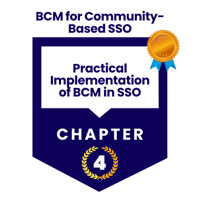Chapter 7
Conclusion: Building a Culture of Care and Continuity
![[BCM] [SSO] [C7] Conclusion – Building a Culture of Care and Continuity](https://no-cache.hubspot.com/cta/default/3893111/b5cd16e6-e11f-4b42-8349-e043bab8187e.png) Business Continuity Management (BCM) is more than a technical framework — it is a commitment to protect the people and purpose that define a social service organisation.
Business Continuity Management (BCM) is more than a technical framework — it is a commitment to protect the people and purpose that define a social service organisation.
For agencies that serve children, youth, and vulnerable individuals, resilience is not optional. It is a moral and operational responsibility.
This final chapter brings together the key lessons from the earlier sections, emphasising that BCM is a journey of continuous learning and improvement, not a one-time project.
Recap of the Key BCM Phases and Their Relevance
Throughout this series, we explored the seven core phases of BCM and how they can be adapted to the unique context of social service organisations in Singapore.
|
BCM Phase |
Purpose and Relevance for Social Services |
|
1. Project Management (PM) and Sponsorship |
Securing leadership support ensures BCM is prioritised and resourced appropriately. |
|
2. Risk Analysis and Review (RAR) |
Identifying threats such as fires, pandemics, or IT outages helps organisations focus on realistic vulnerabilities. |
|
3. Business Impact Analysis (BIA) |
Clarifies which services — like residential care, therapy, and helplines — must continue under any circumstances. |
|
4. BC Strategy (BCS) Development |
Defines practical solutions such as alternate sites, remote delivery, or staff redeployment to sustain operations. |
|
5. Plan Development (PD) |
Documents clear, step-by-step response procedures to guide staff during crises. |
|
6. Testing and Exercising (TE) |
Builds staff confidence and readiness through simple, realistic drills. |
|
7. Program Management (PgM) |
Keeps BCM alive by embedding it into organisational culture, governance, and continuous improvement. |
These phases form a structured yet flexible roadmap. Whether an organisation is just starting or already has risk management practices in place, the BCM framework provides a foundation for protecting both services and people.
BCM as a Journey, Not a One-Time Project
Implementing BCM is not a checklist to be completed and filed away. It is a journey that evolves with the organisation, its people, and the environment it operates in.
Disruptions are unpredictable — from pandemics and cyberattacks to staff shortages or building incidents. Each challenge tests the organisation’s preparedness and adaptability.
Over time, with every drill and real-life event, the organisation’s BCM maturity grows — transforming from reactive to proactive, and finally to resilient.
This journey is sustained by leadership commitment, regular reviews, and a culture where everyone — from caregivers to administrators — understands their role in maintaining continuity of care.
Start Simple, Protect What Matters Most
Many social service organisations worry that BCM requires large budgets or complex tools. The truth is, it’s perfectly fine — and often wise — to start small.
- Begin by identifying your most essential services — such as residential care, therapy, or helplines.
- Develop basic contact lists, emergency communication trees, and evacuation procedures.
- Involve your frontline staff — they know the critical daily routines that must be protected.
- Strengthen partnerships with nearby facilities, vendors, and community networks to support mutual efforts.
What matters most is protecting the well-being and safety of children and youth — ensuring that care continues, even when disruptions occur.
Building Resilience Gradually
Resilience is built step by step.
Each drill, each lesson learned, and each review brings the organisation closer to a culture of readiness.
Sustained resilience comes from:
- Regular training and awareness for staff.
- Continuous plan updates after exercises or incidents.
- Encouraging innovation and flexibility in how services are delivered.
- Maintaining strong communication channels with funders, regulators, and the community.
Through consistent effort, BCM becomes part of the organisation’s DNA — a quiet strength that supports every act of care and service.
Closing Thoughts
In the world of social services, resilience is compassion in action.
It means making sure that children have a safe place to sleep, that therapy sessions continue despite disruptions, and that families can trust their caregivers even in times of uncertainty.
Business Continuity Management is not just about protecting operations — it is about protecting lives and trust.
By starting small, staying committed, and growing steadily, every social service organisation can build a resilient foundation that safeguards its mission for years to come.
More Information About Business Continuity Management Courses

 To learn more about the course and schedule, click the buttons below for the BCM-300 Business Continuity Management Implementer [B-3] course and the BCM-5000 Business Continuity Management Expert Implementer [B-5].
To learn more about the course and schedule, click the buttons below for the BCM-300 Business Continuity Management Implementer [B-3] course and the BCM-5000 Business Continuity Management Expert Implementer [B-5].
![Register [BL-B-3]*](https://no-cache.hubspot.com/cta/default/3893111/ac6cf073-4cdd-4541-91ed-889f731d5076.png) |
 |
 |
 |
 |
 |
![FAQ [BL-B-3]](https://no-cache.hubspot.com/cta/default/3893111/b3824ba1-7aa1-4eb6-bef8-94f57121c5ae.png) |
If you have any questions, click to contact us.
|
 |
 |
 |
 |





![[BCM] [SSO] [C1] BCM for Community-Based Social Services Organisations](https://no-cache.hubspot.com/cta/default/3893111/abcc60b1-a41a-47de-b0d5-84644744d776.png)
![[BCM] [SSO] [C2] Understanding BCM in Social Service Organisations](https://no-cache.hubspot.com/cta/default/3893111/8dbf8f0f-371f-437c-a7d7-ccaff00b9433.png)
![[BCM] [SSO] [C3] Building a Practical BCM Framework for Social Service Organisations](https://no-cache.hubspot.com/cta/default/3893111/879387df-1aee-4517-8d38-fa33138b82ab.png)

![[BCM] [SSO] [C5] Case Study – Fire in a Residential Care Facility](https://no-cache.hubspot.com/cta/default/3893111/f18526eb-1b38-42a2-9c7d-52afe2121435.png)
![[BCM] [SSO] [C6] Governance and Sustainability in BCM](https://no-cache.hubspot.com/cta/default/3893111/fc72acdb-d95e-4823-b7bf-27ce15cc7542.png)
![Email to Sales Team [BCM Institute]](https://no-cache.hubspot.com/cta/default/3893111/3c53daeb-2836-4843-b0e0-645baee2ab9e.png)

